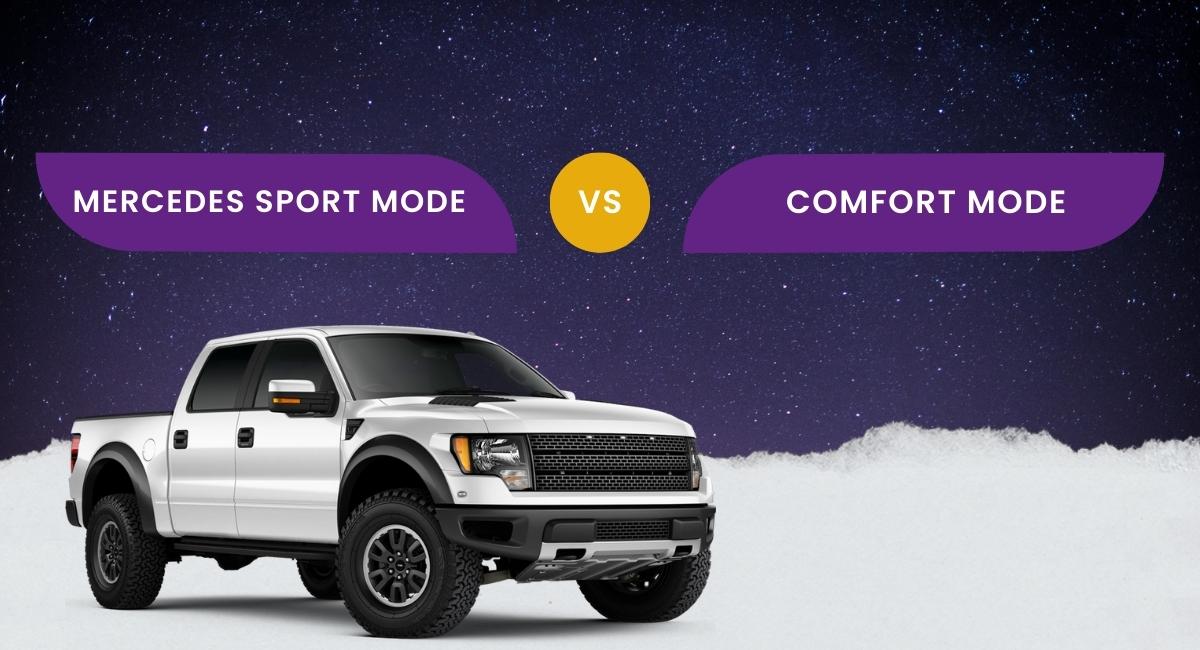When you slide behind the wheel of your Mercedes, you’re not just entering a car but a world of driving possibilities. And at the heart of that experience lie two powerful options: Sport Mode and Comfort Mode. These distinct driving modes have a design that offers a unique blend of performance and comfort, allowing you to tailor your driving experience to suit your mood and the road ahead.
Mercedes-Benz is known for producing luxury vehicles that offer outstanding performance and comfort. Moreover, these modes provide distinct driving characteristics, allowing drivers to tailor their experience to their preferences.
In this article, we will tackle the differences between Mercedes Sport Mode and Comfort Mode, explore the impact on fuel efficiency, and address common misconceptions. So, whether you’re a Mercedes owner or are considering buying one, read on to gain a complete understanding of these modes and how they can improve your driving experience.
Mercedes Comfort Mode: Embracing Serenity
Mercedes Comfort Mode has a relaxed driving experience. When engaged, it adjusts various vehicle parameters to optimize comfort and minimize the transmission of road imperfections to the cabin.
The suspension system is set to a softer setting, providing a more forgiving ride over bumps and uneven surfaces. It translates to a serene driving experience, especially on long journeys or in urban environments.
In Comfort Mode, the throttle response is gentler compared to Sport Mode. This characteristic ensures that the acceleration is more gradual, offering a sense of calm and composure behind the wheel—additionally, the transmission shifts at lower RPMs, promoting a seamless and effortless driving experience.
Mercedes Sport Mode: Unleashing the Thrill
We have Mercedes Sport Mode, engineered to deliver a more dynamic driving experience. When activated, Sport Mode adjusts the suspension to a firmer setting, providing improved stability and sharper handling, allowing enhanced control during spirited driving or winding roads. Sport Mode brings out the sportier side of a Mercedes vehicle, unlocking its performance potential.
The throttle response becomes more immediate in Sport Mode, enabling quicker acceleration and a heightened sense of responsiveness. This feature is especially beneficial for those seeking a more engaging and exhilarating driving experience.
In Sport Mode, the transmission holds onto lower gears for longer, allowing the engine to rev higher and facilitating more aggressive shifting. This results in quicker gear changes and increased power delivery.

Gas Consumption in Sport Mode vs. Comfort Mode
Some drivers wonder if Sport Mode inherently uses more gas. While Sport Mode does provide a more spirited driving experience, which can encourage a more aggressive driving style, it is ultimately up to the driver to determine the fuel consumption.
Utilizing Sport Mode occasionally or during spirited driving on open roads may result in slightly higher fuel consumption, as the engine operates at higher RPMs. However, the impact on fuel efficiency will largely depend on the driver’s behavior and the duration of Sport Mode usage.
Comfort Mode has a design that prioritizes a smoother and more relaxed driving experience, adjusting various vehicle parameters to optimize comfort and minimize the transmission of road imperfections to the cabin.
While it is true that a more gentle throttle response and lower RPM shifting in Comfort Mode can promote a fuel-efficient driving style, the difference in fuel consumption between Comfort Mode and other modes is generally negligible.
Factors that Affect Fuel Efficiency in Mercedes Sport and Comfort
Various factors can influence the fuel efficiency of a Mercedes in Sport and Comfort modes. For instance, the driving mode itself plays a role in fuel consumption.
Additionally, other factors affect fuel efficiency in both modes, and they include:
- The driver’s behavior and driving style, regardless of the selected mode. Aggressive driving habits, such as rapid acceleration, hard braking, and excessive speed, have a far more significant impact on fuel consumption than the choice of mode alone. Regardless of the mode selected, maintaining a steady and moderate driving style, avoiding unnecessary acceleration and braking, and adhering to speed limits are effective ways to maximize fuel efficiency.
- Maintaining a consistent speed within the optimal range for fuel efficiency can help improve mileage.
- Driving on hilly or uneven terrain can increase fuel consumption due to the additional work required from the engine.
- Properly inflated tires can minimize rolling resistance, resulting in improved fuel economy.
Comfort Mode’s focus on providing a smooth and relaxed driving experience may encourage drivers to adopt a more comfortable driving style, which can contribute to a more fuel-efficient approach. However, it is ultimately up to the driver to determine the fuel efficiency level by practicing mindful driving habits.
In optimizing fuel efficiency, it is wise to maintain a consistent speed, anticipate traffic conditions to minimize unnecessary acceleration and braking, and adhere to regular vehicle maintenance schedules.
Additionally, eco-driving techniques, such as coasting when safe and feasible, using cruise control on highways, and reducing excess weight in the vehicle, can further enhance fuel efficiency regardless of the selected driving mode.
Performance and Safety in Mercedes ESP Sport vs. Comfort
Mercedes vehicles often come equipped with ESP (Electronic Stability Program). This dynamic handling system enhances performance and safety. ESP is integrated with Sport Mode and Comfort Mode to optimize vehicle stability and control.
Read More: Why is My Car Jerking After an Oil Change?
In Sport Mode, ESP may allow for a higher threshold of vehicle dynamics, giving drivers more freedom to push the limits of their Mercedes. It can result in increased maneuverability and a heightened sense of engagement. On the other hand, Comfort Mode emphasizes stability and smoothness, with ESP intervening more readily to ensure a secure and composed driving experience.
Mercedes Sport Mode Always On: Convenience and Flexibility
It is worth noting that some Mercedes models can save the selected driving mode as the default mode when the vehicle starts. This feature ensures that your preferred mode, Sport or Comfort, is always engaged upon starting the car. However, it’s important to remember that you can easily switch between modes at any time, allowing for flexibility based on driving conditions or personal preference.
Balancing Performance and Comfort
Mercedes Sport Mode and Comfort Mode offer distinct driving experiences tailored to different preferences. Comfort Mode prioritizes a smooth and relaxed ride, while Sport Mode enhances performance and driver engagement.
While Comfort Mode may contribute to a slightly more fuel-efficient driving style, the driver’s behavior is the primary determinant of fuel consumption. It’s essential to drive responsibly and adapt the driving mode to suit the situation while enjoying the capabilities and versatility of these modes in your Mercedes. So, whether you crave the thrill of sporty driving or seek serenity on the road, Mercedes has you covered with its Sport Mode and Comfort Mode options.
